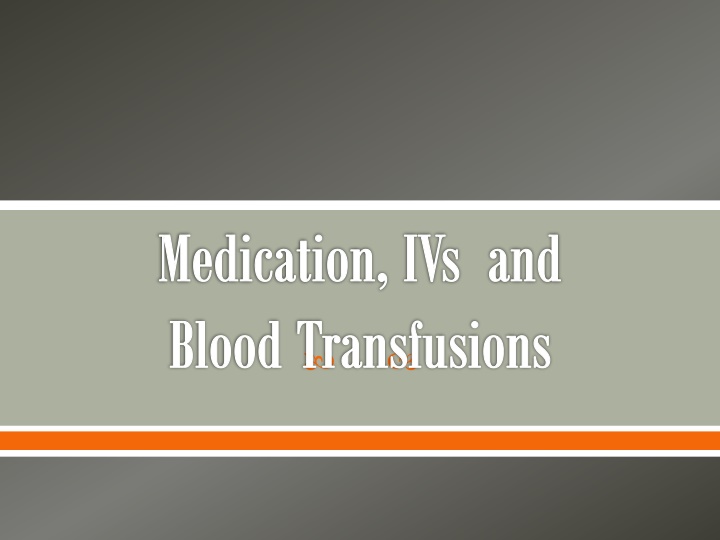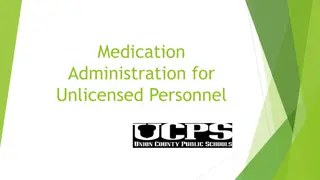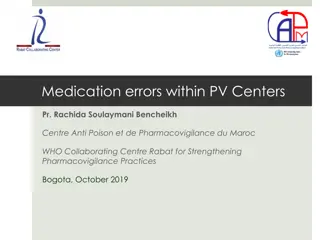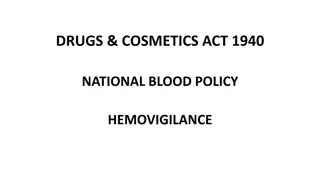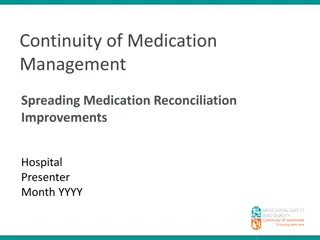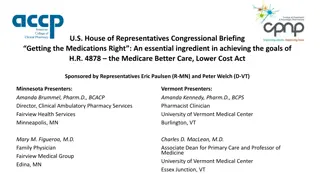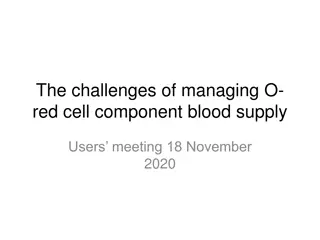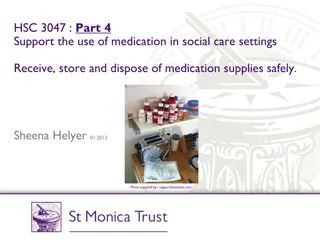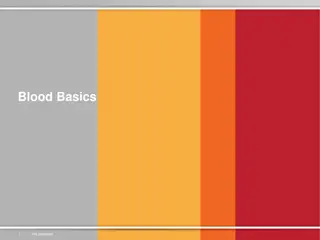Medication, IVs and Blood Transfusions
This comprehensive guide covers medication administration policies, reconciliation protocols, responsible personnel, and proper administration procedures for healthcare professionals. Topics include medication reconciliation upon admission, who can administer medications, and essential steps for safe drug administration.
Download Presentation

Please find below an Image/Link to download the presentation.
The content on the website is provided AS IS for your information and personal use only. It may not be sold, licensed, or shared on other websites without obtaining consent from the author.If you encounter any issues during the download, it is possible that the publisher has removed the file from their server.
You are allowed to download the files provided on this website for personal or commercial use, subject to the condition that they are used lawfully. All files are the property of their respective owners.
The content on the website is provided AS IS for your information and personal use only. It may not be sold, licensed, or shared on other websites without obtaining consent from the author.
E N D
Presentation Transcript
Medication, IVs and Blood Transfusions
Medication Administration Policies
Upon Admission MUSTS MUSTS o Document patient s Height, Weight, and Allergies Document weight in Kg Document weight in Kg o Reconcile patient medications the physician must reconcile all medications and address deficiencies / discrepancies Utilize the pharmacist to provide opportunities to make recommendations to streamline medication therapies.
Medication Reconciliation Complete upon arrival to unit o Must be completed BEFORE the Pharmacy can fill prescription orders o Tips to obtaining information from the patient BE THOUROUGH Ask the patient what they think the med is used for Ask what (any and all) over-the-counter or herbal meds are used Ask the patient when they took the last dose Watch for duplications Medication duplications Therapeutic duplications Watch for adverse reactions Ask the pharmacist to help on admission They are trained to interview on medication histories They can quickly catch duplications They can catch side-effect chasing
Who Can Administer Meds o RNs GNs RNs GNs Restrictions Chemotherapeutic (only approved RNs) o Student Nurses Student Nurses under the supervision of RN o PT PT topical drugs related to treatment o Radiology Tech Radiology Tech radiology drugs / agents o CRRT, RRT CRRT, RRT respiratory therapy meds Everyone is Responsible for Education Everyone is Responsible for Education o Provide Patient and Family education regarding potential side effects etc.
How to Administer Use 2 identifiers Use 2 identifiers o Patient s Full Name, Date of Birth Verify drugs to be administered with order Verify drugs to be administered with order o Order must be complete: Order must be complete: Date / Time Date / Time Drug Name Drug Name Drug Strength Drug Strength Route Route Frequency Frequency PRN Qualifier (if necessary) PRN Qualifier (if necessary) Signature of Prescriber Signature of Prescriber o Order must conform to CMS rules and regulations Order must conform to CMS rules and regulations o Order must conform to The Joint Commission regulations Order must conform to The Joint Commission regulations
How to Administer (continued) Refer to MAR to ensure dose is correct Refer to MAR to ensure dose is correct o not contraindicated by Allergy Sensitivity Diagnosis Use 5 Rights: Use 5 Rights: Right Patient Right Drug Right Dose Right Route Right Time
Medication Orders PRN Orders o Qualifiers If a drug has only one indicator, then a qualifier is not needed Ambien 10 mg q hs prn If a drug has more than one indication, then a qualifier is required Tylenol 650mg q 4 hr. PRN headache Hold Orders o Are interpreted as discontinued Titrate Orders o Must include parameters both at lower limit and upper limits, when applicable to the drug headache
What Do You Do If.? Refused Doses Refused Doses o Return reusable drug to the Patient s supply or ACCU-Dose. o Destroy unusable refused drugs o Document administration or refusal of drug o Inform physician of patient refusal Discontinued Meds Discontinued Meds o Remove from the patient s drug supply o Return to the Pharmacy Discharged patients Discharged patients o Remove drugs o Place in pharmacy pickup container or return to pharmacy
What Do I do In Case of A Drug Error or Adverse Reaction? Report to attending physician Complete a Variance Report Report incompatibilities to the Pharmacy
Controlled Substance Discrepancies All discrepancies will be reviewed and reconciled prior to the end of shift. o All staff will remain on site until resolved o Supervisor and Pharmacist will be notified All discrepancy resolutions will be reviewed by the House Supervisor o except in OR reviewed by OR Director or Charge Nurse If discrepancy can not be resolved, Director of Pharmacy, CNO, or the Administrator On Call will be notified immediately o Drug Screens per hospital policy
Wasting Controlled Substances Wastage of controlled substance o Witnessed by RN or physician o Documented by both parties in Accu-Dose o Destroy wastage Liquids waste in the Sharps Container Patches fold (sticky side together) place in Sharps Container
IV Therapy Adult / Pediatric Peripheral Central and PICC
Peripheral Site / Catheter Selection Always choose the distal most site available Always choose the distal most site available based on o Patient Condition o Age o Site Availability o Medication to be infused o Treatment to be administered o Duration of infusion Catheter Selection o 20 gauge for adults is typical Use Alcohol Impregnated Port Protectors Use Alcohol Impregnated Port Protectors ( ( Swabcaps CUROS tips) CUROS tips) on all IV access ports and connectors on all IV access ports and connectors Swabcaps and and
Peripheral IV Catheter/Site Monitoring Peripheral IV site can remain Exception IVs placed by EMS must be replaced within 24 hours of site placement Adult patients that have limited venous access o Dressing Change Every 96 hours (4 days) Sooner if needed Document on dressing Date Time Catheter size Initial
Pediatric Peripheral IVs IV starts o 2 attempts / 2 RNs only call physician for instructions Site Selection o Scalp veins may be used in infants less than 9 months of age o Hands and arms for infants and older children o Patients > 3 years of age order required to initiate in feet IV Tubing / Buretrols / Pumps o All patients < 40 Kg require an IV pump AND a Buretrol with no more than 2 hours of IV fluids in the chamber o IV meds are given via Syringe Pump o All medication infusions MUST be check by 2 RN on patient less than 3 years of age
IV Catheter Site Monitoring o Monitor for signs of complications document in EMR o Assess site for bleeding, redness, swelling, tenderness, induration and drainage Q 12 hours - saline lock Q 2 hours continuous infusion Q 1 hour pediatric With every IV med administration
ITRACE process for Assessing Sites I I - - I Illuminate pt care area when lines are manipulated T T - T Touch the line and T Trace it from insertion (patient) to point of origin R R - - Perform Cognitive R Review purpose of IV, outcome, 2 patient identifiers used, etc A A - A Act if difference in planned and desired outcome C C - - C Clarify and C Correct concerns that are expressed. Correct any discrepancies before proceeding E E - - E Expect to use the ITRACE process each time a line is accessed, manipulated or discontinued AND when handoff to anther clinician.
When to Replace IV Fluid Tubing o Primary and Secondary o TPN / PPN o Blood Saline Lock connectors Injection caps for PICC lines 24 hours 96 hours 24 hours every 2ndunit 72 hours 7 days
When to Flush Adult Adult Peripheral Catheters Peripheral Catheters o Every shift o Before and after all med administrations Use 100 ml NS bag for flush IV piggybacks, run through saline lock 3 ml NS Central Lines / PICC Central Lines / PICC o Every 8 hours (all ports) o Before and after all med administrations 10 ml NS Pediatric Pediatric Peripheral Catheters Peripheral Catheters o Every 8 hours o Before and after all med administrations 2 ml NS
When to Change Dressings o Transparent dressings o Gauze dressings every 7 days every 2 days Change initial Central Line and PICC line dressing after 24 hours. Change any dressing sooner if it becomes damp, loosened, or visibly soiled.
Central Lines Types o Non Tunneled o Tunneled Catheter o PICC line o Implanted Port
Central Lines Non-Tunneled Central Lines are IV access lines placed in the high flow, large centrally located veins of the body. o Internal Jugular vein o Subclavian Vein o Femoral Vein Used for long term IV Fluid administration, TPN, or if the patient does not have peripheral access Inserted by the physician
Central Lines -Tunneled Brands o Hichman / Broviac o Groshong Surgically inserted Threaded under the skin Manage like all other Central Lines
Central Lines -PICC Used for moderate to long term need for fluids, antibiotics, etc Can be inserted by trained RN Usually placed in median cephalic, basilic or cephalic veins
Implanted Ports Implanted subcutaneously Port-a-caths most common brand No dressing is required o Exception when accessed Flushed with Heparin Accessed with Huber Needle (non-coring)
PICC Line Maintenance Flush o every 8 hours o 10 mL NS o With syringe 10 mL o NEVER smaller Dressing Change o Initial 24 hours o Every 7 days thereafter Assess site for bleeding, signs of infection with hourly rounds Complications o Occlusion or clotting USE PULSATION method with flush o Mechanical phlebitis / Thrombosis Secure o Catheter leak o Accidental removal Measure length of catheter - awareness SECURE
Nurse Role with Central Lines Initial - After Insertion o Obtain Chest X-Ray after insertion o Do not access the central line until placement has been verified. Obtain physician order to use o Flush all all lumens to maintain patency o Monitor site for bleeding o Assess breath sounds o Assess circulation o DOCUMENT insertion, site, dressing and flushing Ongoing o Flush each lumen q 8 hours before and after use 10 ml NS o Close clamps to each lumen when not in use o Dressing changes Initial 24 hours after placement Thereafter 7 days o Monitor for infection
Most Common LASA Drugs Administered at SMCHH Joint Commission Standard ISMP s List of Confused Drug Names http://www.ismp.org/Tools/confuseddrugnames.pdf cloNiDine cloNiDine diFlUcan diFlUcan DOPamine DOPamine ePHEDrine ePHEDrine hydrOXYine hydrOXYine metFORMIN metFORMIN MUCOmyst MUCOmyst Solu Solu- -MEDROL MEDROL Wellbutrin SR Wellbutrin SR Zestril Zestril clonazePAM clonazePAM diPRIVan diPRIVan doBUTamine doBUTamine EPINEPHrine EPINEPHrine hydraALAZINE hydraALAZINE metroNIDAZOLE metroNIDAZOLE muciNEX muciNEX Solu Solu- -CORTEF CORTEF Welbutrin Welbutrin XL zeTIA zeTIA XL
Antibiotics Administer the first dose of antibiotic ASAP: o Within an hour of the order o Call the pharmacist if times MUST be adjusted from standard times o Rationale: studies show better efficacy oBe aware of drugs requiring Peak and Trough for continued administration. o Antibiotics requiring Peak and /or Trough Gentamycin and Gentamycin and Vancomycin Vancomycin doses CANNOT be given less than 6 hours apart Both are Nephrotoxic can lead to acute renal failure Monitor Creatinine and BUN Gentamycin is also Ototoxic
Nursing Considerations for Vancomycinand Gentamicin Vancomycin o Monitor Creatinine and BUN o Peak draws should be scheduled prior to the 4th or 5th doses o Trough draws should be drawn 30 60 minutes before the dose is administered (during the day preferably) o Administration Doses 2000mg should be given over 2 hours Doses 2000 2500mg should be given over 3 hours Gentamicin o Trough only Obtain a 4 hour pre-dose draw / level before administering the second dose Target trough result undetectable 0.5mcg/mL
Medication Administration: High Risk Drugs Requires 2nd nurse verification upon administration o Documentation on MAR Which drugs are HIGH RISK? Think PINCH o P P Potassium Potassium o I I Insulin Insulin o N N Narcotics (high concentration) Narcotics (high concentration) o C C Chemotherapy Chemotherapy o H H Heparin Heparin
PCAs Patient-Controlled Analgesia Must be 6 years of age to use a PCA Requires 2 RNs to o initiate, set up, change syringes and discontinue Monitoring clinical data upon initiation o Every 15 minutes X 4 o Every 30 minutes X 4 o Every 4 hours thereafter
Isotonic IV Fluids Similar to plasma Remains within the extracellular compartment Increases intravascular volume Examples: 0.9% NS lactated Ringers D5W - is isotonic but becomes hypotonic and causes fluid to shift into cells Uses: Volume Deficit: Hemorrhage, severe vomiting/diarrhea, heavy drainage from GI suction, wounds Shock Mild hyponatremia Metabolic acidosis Resuscitation efforts ONLY fluid used with administration of blood products
Hypotonic IV Fluids Have a lower concentration of solutes (electrolytes) Lowers serum osmolality within the vascular space causing fluid to shift from intravascular space to intracellular and interstitial spaces Examples: o 0.45% NaCl Uses: o Hypernaturemia o Diabetic ketoacidosis NEVER give to patients At risk for increased ICP (may exacerbate cerebral edema) Liver disease Trauma Burns
Hypertonic IV Fluids Have a higher osmolarity than plasma o Draws water out of the intracellular space o Increases extracellular fluid volume Examples o D5NS Used as a volume expander o Severe hyponatremia o Cerebral edema Precautions o Potential for causing intravascular fluid volume overload and pulmonary edema o Should only be administered in high acuity areas with constant surveillance for potential complications
TPN / PPN TPN TPN Total Parental Nutrition Total Parental Nutrition o Must be administered through a Central Line Must be administered through a Central Line o Contains: Contains: Proteins Proteins Carbohydrates Carbohydrates Lipids (SMCHH administers Lipid separately) Lipids (SMCHH administers Lipid separately) PPN PPN Partial Parental Nutrition Partial Parental Nutrition o Can be administered through a Central Line or Peripheral line Can be administered through a Central Line or Peripheral line o Contains Contains Proteins Proteins Carbohydrates Carbohydrates
TPN / PPN Uses o Patients with non-functioning GI tract o Patients who need complete bowel rest Central Line should not be used for anything thing but the TPN / PPN Tubing changed Tubing changed - - every 24 hours every 24 hours Dressing changed / labeled with date, time and initials Dressing changed / labeled with date, time and initials every 48 hours every 48 hours Infusion start slowly 50% of calculated requirement Insulin will be added to bag o Monitor Glucose level regularly (q 6 hours until stable o Supplement insulin via scale as needed q 6 hours until stable)
IV Drips: Lasix, Dopamine, Dobutamine
Lasix (FUROSEMIDE) Diuretic used in the treatment of o CHF o Pulmonary Edema o Acute Renal Failure Mechanism of Action o Loop diuretic o Inhibits reabsorption of Na+ and Cl- at the proximal and distal renal tubules and Loop of Henle. o Decreases water reabsorption
Lasix (FUROSEMIDE) Administration oOral oIV push oContinuous IV: Check for compatibility with other IV drugs Check to ensure patient has a functioning IV site Prepared in pharmacy, a 1:1 mixture(1 mg= 1 ml)
Lasix (FUROSEMIDE) Nursing Implications o Vital signs q4h o Daily weights o Monitor urine output q4h o Daily labs: Serum electrolytes, BUN/Cr, and CBC o Monitor for muscle cramping o Monitor for hearing loss o Monitor telemetry rhythm as per remote tele protocol o Obtain ECG as ordered
Heparin Infusion Anticoagulant used in the treatment of: o Deep Vein Thrombosis o Pulmonary Embolism o Atrial Fibrillation o Acute Coronary Syndrome Mechanism of Action o Inhibits the mechanisms that induce the clotting of blood and the formation of stable fibrin clots at various sites in the normal coagulation system.
Heparin Infusion Nursing Implications Nursing Implications o Verify MD order for infusion and protocol Notify MD if other anticoagulant therapy is not Notify MD if other anticoagulant therapy is not discontinued with Heparin infusion order ( discontinued with Heparin infusion order (eg Arixtra Arixtra, , subQ subQ Heparin) Heparin) o Obtain baseline labs: CBC, PTT, INR o Obtain 2 large bore IV sites, if possible o Two nurses must verify initial bolus dose and rate o PTT 6 hours after every dose change o PTT every 6 hours until 2 consecutive PTTs are in therapeutic range, then order PTT Q24H o Adjust Heparin Infusion according protocol eg/ / Lovenox Lovenox, ,
Heparin Infusion Contraindications o Uncontrolled, active bleeding o Known history of Heparin Induced Thrombocytopenia o Development of thrombocytopenia while receiving Heparin therapy Administration at SMCHH o Premixed from Pharmacy o 25,000 units in 500ml of D5W o Weight Based Adjustment o Refer to Heparin Protocol (Public Drive, Nursing Protocols Folder) Check for compatibility with other IV drugs Check to ensure patient has a functioning IV site
